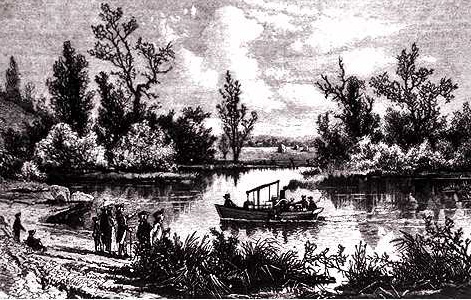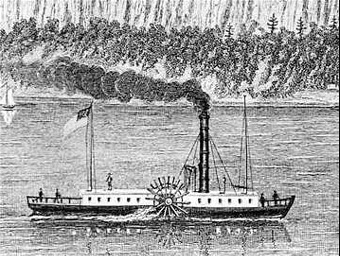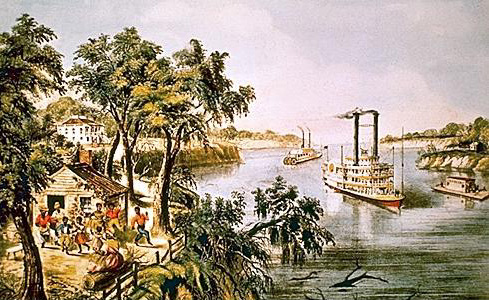 About Steamboats...
About Steamboats... About Steamboats...
About Steamboats...The steamboat was often the only mechanical means of river travel and freight transportation from 1808 through 1930. While writers like Mark Twain romanticized the steamboat life, most of the vessels were workhorses and their environment was rustic. The hull, a simple cabin, boilers for steam, engines powering propellers or paddle wheels, and space for freight and passengers comprised the basic features of steamboats. The pilot house, often more than fifty feet above the water, was the center of operations. A huge ship's wheel controlled rudders on some boats while engine speed varying paddle wheel speed steered side-wheelers. Firing the boilers was accomplished with wood in the early years. Later oil and coal would provide combustion.
 |
| John Fitch's trial run |
People familiar with the term often think of steamboats as the paddle wheel-driven boat with the shallow draft commonly seen on the Mississippi River in the 19th and early 20th centuries. While any steam powered boat qualifies as a steam boat, it is the popular image that we intend with our usage, for it was these vessels that made East St. Louis a central transportation point along the Mississippi River. There were two general types of steamboats plying the rivers of nineteenth century America. The East Coast steamboat was used in coastal bays, harbors, and rivers throughout the East Coast. This was a deep-draft vessel propelled by steam engines that drove paddle wheels or propellers. The boats that traveled the waters of the Mississippi were Western steamboats with shallow-drafts and of much cruder construction, employing a sidewheel, sternwheel, or, occasionally, propeller propulsion. The western type of steamboat also found use in the South (below Virginia) and in the Gulf Coast region.
Although two types of steamboats dominated American waters, there were many different classes. Towboats moved cargo by pushing barges up and down rivers, ferries such as those operated by Henry Wiggins transported goods and people across water, packets carried freight, mail, and people, fuelers met other steamboats along the river and resupplied them with wood, coal or oil, snag boats kept waterways clear, and showboats offered entertainment.
 |
| A pen and ink sketch of the Clermont |
The most common steamboat on the Mississippi was the packet. These vessels varied greatly in size and amenities. Much of American agriculture and general commerce came to rely on packets throughout the nineteenth century. On many such boats there was a single first-class deck with the rest of the space cramped and uncomfortable. The boat's crew was often composed of slaves and various types of free labor. Crewmen were often transient, moving from job to job, seeking better conditions in what was strenuous, low-paying labor. Unfree labor could use the mobility of the boats for a chance to escape, and undoubtedly many did, however, slave crews were also closely watched, often the captain would keep any slaves in chains when not working. There were luxury boats and the few captains who could afford to, maintained images as daring doers who raced each other to win business. The majority of steamboat owners worked hard to make their boat or fleet profitable. Paying crews and maintaining competitive freight charges meant that profits were often slim.
 |
| Low Water in the Mississippi, a lithograph by Currier and Ives, Knox College, Galesburg, Illinois |
Steamboats on the Mississippi grew in American legend, not just because of famous races or luxurious accommodations. These boats were a primary force in western settlement. A Southerner in New Orleans could travel to Minnesota and a Virginian could go to St. Louis. The Mississippi and the rivers that connect to it allowed travel in all directions, but the from the East Coast to the west bank of the mighty river marked a destination that allowed thousands of Americans to move west and begin populating the once calm regions frequented by many different groups of Native Americans.